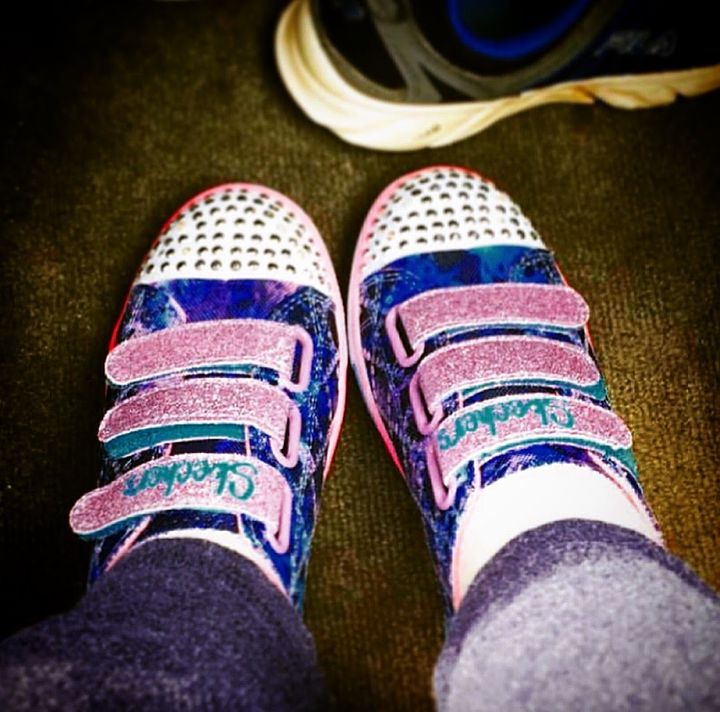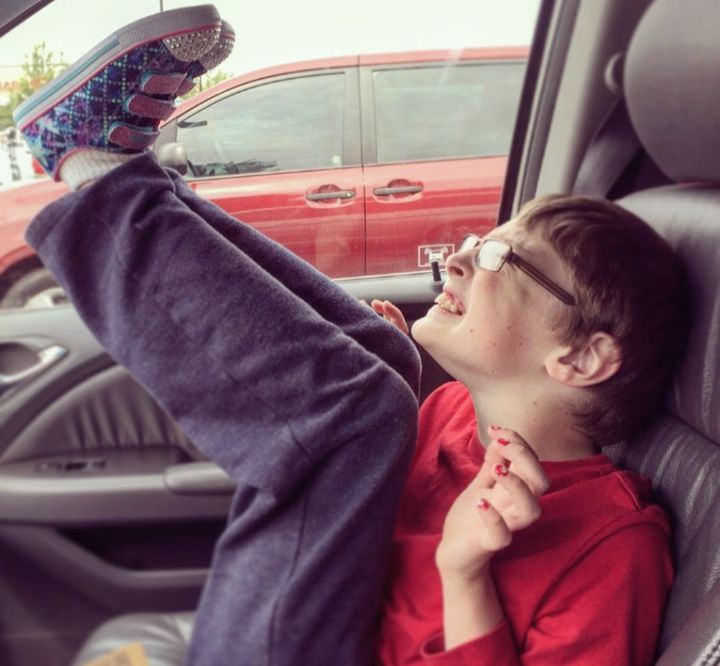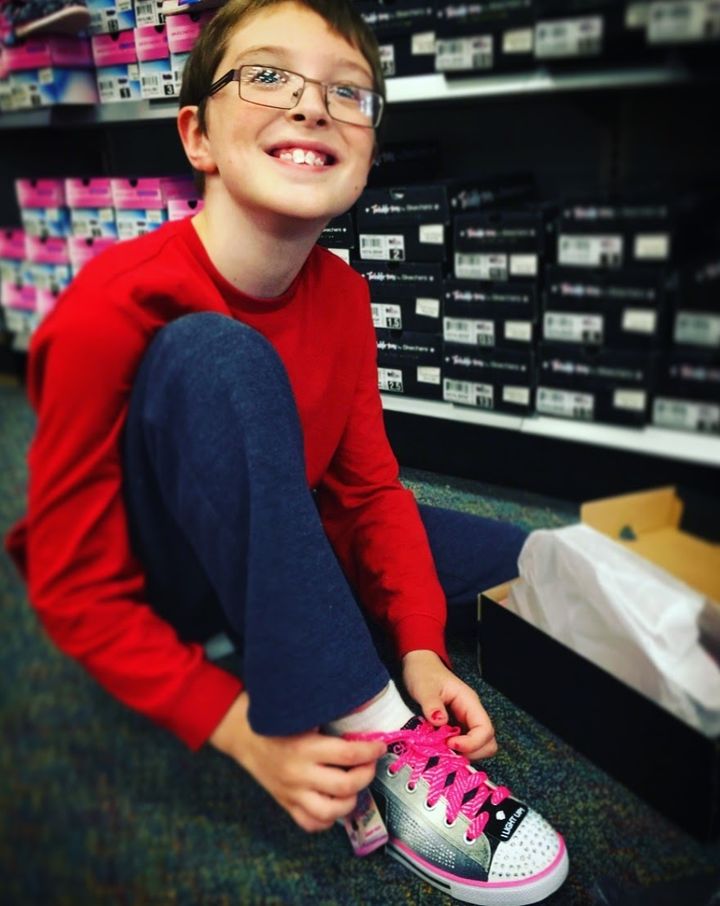
It’s me, the mom who shared the piece that was featured on the front page of HuffPost for a few days: "Why I Refuse to Apologize for My Son Wearing a Dress." And earlier, this one, in the Voices section: "When Your 4th Grade Son is Called 'Gay.'"
Today was our shoe shopping day. My 10-year-old needed shoes badly, as his big toe had finally pushed through the few strands of fabric that were holding the toe cap together for the past two months.
I took my son to the shoe store we've been going to for years. Only this time, as I made my way left to the boys section, my son departed and went confidently to the right, to the girls section. That was a shoe store first, so I followed his lead.
He knew exactly what he was getting, and when the announcement came over the speaker that it was “buy-one-get-one-half-priced day,” he knew exactly which two pairs he was getting. The first pair was pink, sparkly, glittery, shimmery, and they lit up. The second pair was pink, sparkly, glittery, shimmery, and they lit up. The only difference was one had velcro; the other had laces.
These were most definitely feminine-looking shoes. Coincidentally, this particular line of shoes was called “Twinkle Toes.” If memory serves, this was a name hurled as an insult towards more effeminate boys when I was his age.
“The first pair was pink, sparkly, glittery, shimmery, and they lit up. The second pair was pink, sparkly, glittery, shimmery, and they lit up. The only difference was one had velcro; the other had laces.”
I reminded my son that these shoes would also serve as his new school sneakers for the fall.
“I know,” he said with a smile, unfazed.
I said, “Well, at least make sure you look around the store before making a final decision.”
He indulged me by pirouetting his eyes around the store without moving his body. Then he said, “I’m good.”
At this point, I didn’t even know what I was concerned about, because he carried a girl’s backpack to school every day this past year and has already worn a dress in public and girl’s pajamas to school on pajama day. I guess it was just one more step towards independence that made me nervous.
Just to be certain, though, I walked him over to the boy aisle, showed him a random pair of sneakers and said, “Do you like these?”
“Nope,” he responded swiftly. “Too manly.”
I didn’t think anymore and just responded, “Alrighty then, Twinkle Toes it is.”
He also picked out several neon, hot pink, purple, and yellow ankle socks before we checked out, and when all was said and done, we left with two new pairs of shoes and four pairs of good quality socks for under $100 -- a rare occasion when it comes to athletic footwear.
As soon as we got into the car, he peeled off his old blue sneakers, delicately placed the new shoes on his feet, looked down in admiration, took a photo, and posted it to Instagram, hashtag: “SPARKLES!”
I smiled when I saw how happy he looked. Out of curiosity, I asked him, “Why haven’t you picked shoes from the girl’s aisle before today?”
He answered, “Just like with the toys -- I didn’t realize that I could!”
I felt both a sense of guilt and frustration -- guilt because, duh? Why did I assume he would generalize the “gender neutral toy/costume rule” in our house automatically to shoes as well?
I felt frustration, because why can’t all kids just shop for shoes all in the same section? Shoes, even more so than clothing choices, should be gender neutral. Girls can wear Converse and Doc Martens and combat boots with no issue. Why can’t boys’ shoes also come in pink or glitter?
“Out of curiosity, I asked him, “Why haven’t you picked shoes from the girl’s aisle before today?” He answered, “Just like with the toys -- I didn’t realize that I could!””
But I forgot my brain tangent when I looked back at him and he was kicking his feet up in the air, a huge smile of exhilaration spread across his face. I wanted to remember this moment, so I pointed my phone in his direction and captured it.

We had some errands to run after shoe shopping, so we did them with my son proudly wearing his loud, light-up, sparkly, girly shoes. He even leaped a few times between sidewalks and curbs. I was witnessing sheer happiness and freedom. I was witnessing a rockstar. A rockstar in twinkle toe sneakers.
I have some pretty amazing people in my life who I must thank profusely for their concern over the hateful or negative comments we received following my other published pieces. As expected, many of them have been pointed in our family's direction regarding our support of raising a gender creative boy. I want to assure all my lovely friends that despite a world of misunderstanding and sometimes even hatred, we're good. I'm a theatre person who has been picked apart by directors most of my life. A few negative comments on social media will not discourage or sway me to stop talking about this important, ignored "white elephant in the room."
We can no longer to afford to call effeminate young boys names like, "sissy," "pansy," "gay," "fag," or worse. This is an epidemic that has got to stop. There's nothing inherently wrong with words typically associated with femininity, but when those words are used as weapons, as the lowest possible form of male mockery, or to label a kid who doesn't even have sexuality on his or her radar yet, it's absolutely not okay. In fact, it's sexual harassment, and as such, falls under Title IX of the Education Amendments of 1972. Title IX is further clarified by this letter issued in 2010, from the Office of Civil Rights, stating, "Harassment does not have to include intent to harm, be directed at a specific target, or involve repeated incidents." So, despite what is taught in schools, and contrary to the belief of many folks, harassment does not even have to happen more than once for it to be considered harassment.
“There's nothing inherently wrong with words typically associated with femininity, but when those words are used as weapons ... it's absolutely not okay.”
I'm actively choosing to focus instead on all the love that has surrounded us. It truly is overwhelming. Receiving messages from people all over the U.S. and even Canada who have reached out to say, "My child is gender creative, too" has been incredibly heart-warming. I've heard from grown people who were bullied all throughout childhood -- by family, friends, or both. I've heard from parents of gender creative or trans children who, just like me, are looking to connect. In this age of online social media, my son has even gained an old-fashioned, letter-writing pen pal, the gender creative young son of a family I've met on this parenting journey.
Some have reached out, acknowledging the need to continue the conversation that gender expression and/or creativity is nothing new. Perhaps the lingo and terminology are new components, but strongly effeminate young boys and strongly masculine young girls, or any combination thereof, have always been around. Everyone can probably remember at least one from his or her childhood. For every one that we can remember, there were probably twice as many that we were unaware of, who were forced into hiding. Like the boys who were shamed by family or peers, told to "man up," or to "quit being a mama's boy" -- or girls who were asked with raised eyebrows, "you play football?" or, aside comments made and murmured to "go easy on her."
“Perhaps the lingo and terminology are new components, but strongly effeminate young boys and strongly masculine young girls, or any combination thereof, have always been around.”
Gender creative people have been around forever. Just one example lies within Native Americans, who have “Two-Spirited” people in their tribes. Two-Spirited people are said to encompass both genders and often are the most revered people in their culture. So, despite hate speech, people who refuse to understand, or outcries that parents like me are merely “virtue-signaling” on social media, I will keep fighting for equal rights, because I want a better world for my children.
Among the comments, though, were a few recurrent questions, the same questions I've been hearing for years, so they're easy to answer and hopefully can attempt to clear up confusion for people who are interested in understanding. The first most common question is always some form of:
Q). "But how does your husband/his dad feel about this?"
A). I guess some people assume a father figure could not possibly agree to raising a gender creative son. However, I'm happy to report that my husband of nearly 20 years is 100 percent supportive of raising all three of our children exactly as they are. This includes: our oldest, cisgender*, straight, male son; our middle, cisgender*, straight, female daughter; and our youngest, gender creative* male son. We can't determine his sexual preference or gender identity yet (cisgender or transgender). We can only go with what he's telling us, and that's that he is "happy being a boy" but "just likes all 'girly' things." While at first it was a little unnerving for my husband to see his son not grow out of this supposed "phase," he quickly realized, "this is what makes him happy, he's not hurting anyone, and that's really all that matters."
The next most common question/comment we get is some form of:
Q). "That's all fine and good, as long as you're being honest with your son, and being truthful about how hard of a time he's going to have, getting bullied and all..."
A). First, we are all about honesty. We have lots of "family meetings." Pretty much any conversation topic is fair game. But honestly, we haven't really even had to have many of those conversations with our son about how "tough it's going to be," because he has already been experiencing weird looks, rude comments, and intrusive questions his whole life. He doesn't know any other reality. Fourth grade was his hardest year yet, probably because it's the beginning of puberty and thus the beginning of social exclusions that come with kids searching for their unique identities.
“We can't determine his sexual preference or gender identity yet (cisgender or transgender). We can only go with what he's telling us, and that's that he is "happy being a boy" but "just likes all 'girly' things."”
I have always been open about my son's gender creativity, even when he was young and I was searching for resources and support. I'm just speaking from a somewhat bigger platform now. But I didn't begin to speak from a bigger platform until I asked my son if he was okay with it. He was not only okay with it, but was enthusiastic about it. He wants his story told. So that's what I attempt to do.
To address the second part of this concern... saying, "okay, but he's going to have to accept being bullied..." well, that's straight up victim-blaming, and victim-blaming is never okay.
The third most common question we get is some form of:
Q). "But why the need to label? Can't kids just be kids?"
A). In my experience raising three of them, no, because that's not the way it tends to work with kids. Kids are going to get labeled regardless, typically by one another. For kids who are gender different or non-conforming, those labels can be life-crushing. Before our society had the term "gender creative," the common label was "tomboy" for girls, and for boys... well, there was no friendly equivalent. Boys often heard "pansy," "sissy," "faggot," or worse. My son is going to get labeled anyway (already has been, when he was called "gay"), with the intent of horrible degradation. At least now he can attempt to correct his peers and have a chance to educate them by saying, "I'm not gay; I'm gender creative."
No, of course it won't stop the insults. But it gives him a positive rebuttal for people who try and define him until he knows what his sexuality will look like. He has already defined himself, and no one can remove that positive label from him with their negative critiques.
Also, and more importantly, before my son knew about the trans, gender non-conforming, gender creative population, he felt alone and sad. He has always been anxiety-laden and felt like he didn't fit in, but he began spiraling downward, fast, in 4th grade. I showed him videos and photos of kids like Corey Maison, Jazz Jennings, CJ of "Raising My Rainbow," and other kids who identify as trans or gender creative. He had seen several of these kids before, but now it really resonated.
He watched and listened, and just as it was for me when I realized, I watched him have the lightbulb moment when he realized that there are kids out there just like him. Of his own assertion, after being exposed to different types of kids in documentaries and books, he ended up stating, "I am gender creative!"
It was a moment of huge relief for him to suddenly know he was not on an island, and he had people to identify with. He began asking me to start up a gender creative playgroup, where he could be free to play with My Little Pony and princess costumes all he wanted in a judgment-free zone, and maybe, even with like-minded people. I made a promise to him that I would, and I'm happy to say that the S.E.A.R.CH. program (Safe Environment for the Acceptance of Rainbow CHildren*) is starting this summer.
So about labels -- if they are something that gives a kid hope, comfort, positive associations, and a rebuttal towards hurtful comments, then I'm fine with labels. Sometimes labels are not only helpful but absolutely necessary when trying to get a child the educational, medical, psychological, and/or legal services or protections that they're entitled to.
“About labels -- if they are something that gives a kid hope, comfort, positive associations, and a rebuttal towards hurtful comments, then I'm fine with labels.”
My husband and I are totally following our son's lead on this, and we have always been honest with him about the hateful people out there. He knows. And yet he still chooses to be himself. I thought I would spare him the hateful comments that have been thrown our way now more than ever. But I ended up sharing one with him, so that he would know what some people are saying, and he’d hear it from me and not someone else. I told him of a few comments where I was labeled a “bad parent.”
My son’s response? His jaw dropped, he stared at me for a minute before saying, “May I have permission to curse?” to which I hesitantly said, “Um...yes,” and he answered, without hesitation, “THOSE. LITTLE. BITCHES.” I couldn't help but laugh it off, and so did he. But he continued to shake his head and say, “Bad mom? That’s just insane.”
The point remains the pieces I published accomplished exactly what our family wanted, and that was to start a dialogue about why we're so afraid of differences. Whether the gender spectrum is understood or not, embraced or hated, people are talking about it, and that's exactly what needs to happen in our country right now. It's time to break down gender stereotypes. Maybe then we can begin to see our LGBTQ community and our gender non-conforming people as equals. We have come a long way, but there's still a much longer way to go.
Hurtful comments and actions from other kids (and even some adults) who don't understand can hurt someone like my son, because they're young and don't have a lifetime of experience or extremely thick skin yet. But even in the face of that, with our encouragement at home (and I do mean encouragement from our whole family -- me, his two siblings, and his dad, who is probably his biggest cheerleader), our son continues to live happily -- exactly as himself.
*Cisgender: A person whose self-identity conforms with the gender that corresponds to their biological sex. (The opposite of transgender).
*Gender Creative: A person, typically a child, who (in the words of Diane Ehrensaft, Ph.D.), “defies nature and nurture.” This is the child who doesn’t think in binary terms, who does not necessarily want to change their anatomy or be the opposite gender, but typically prefers things associated with the opposite gender.
*Rainbow Children: A broader, more “umbrella” term that I prefer using that describes gender non-conforming children who aren’t yet sexually identifying.
